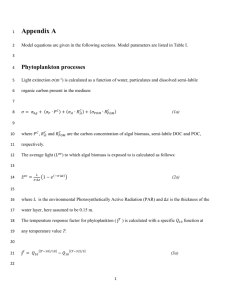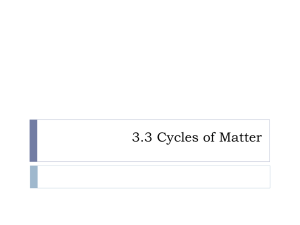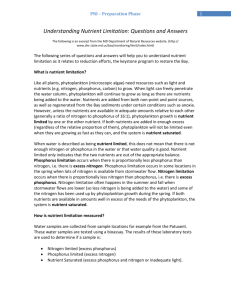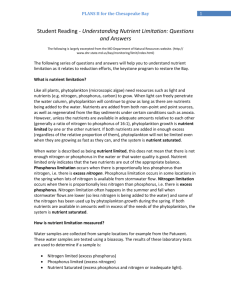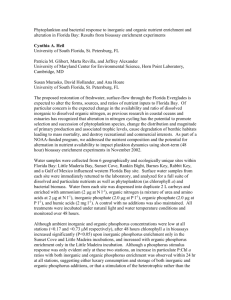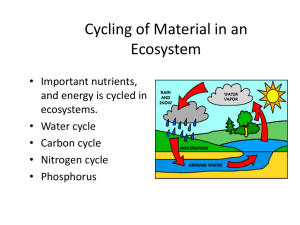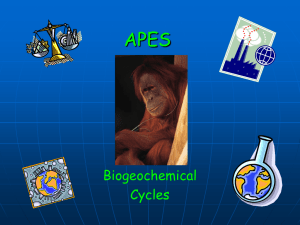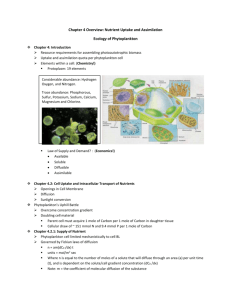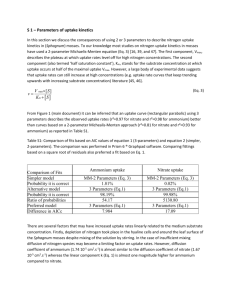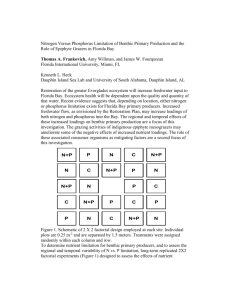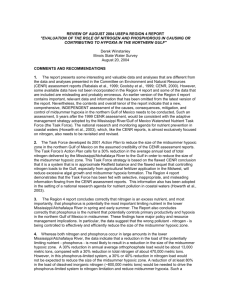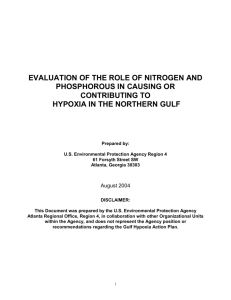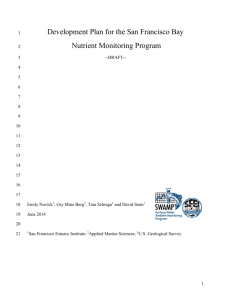Stoichiometry of the dissolved and particulate nutrient pools, and
advertisement
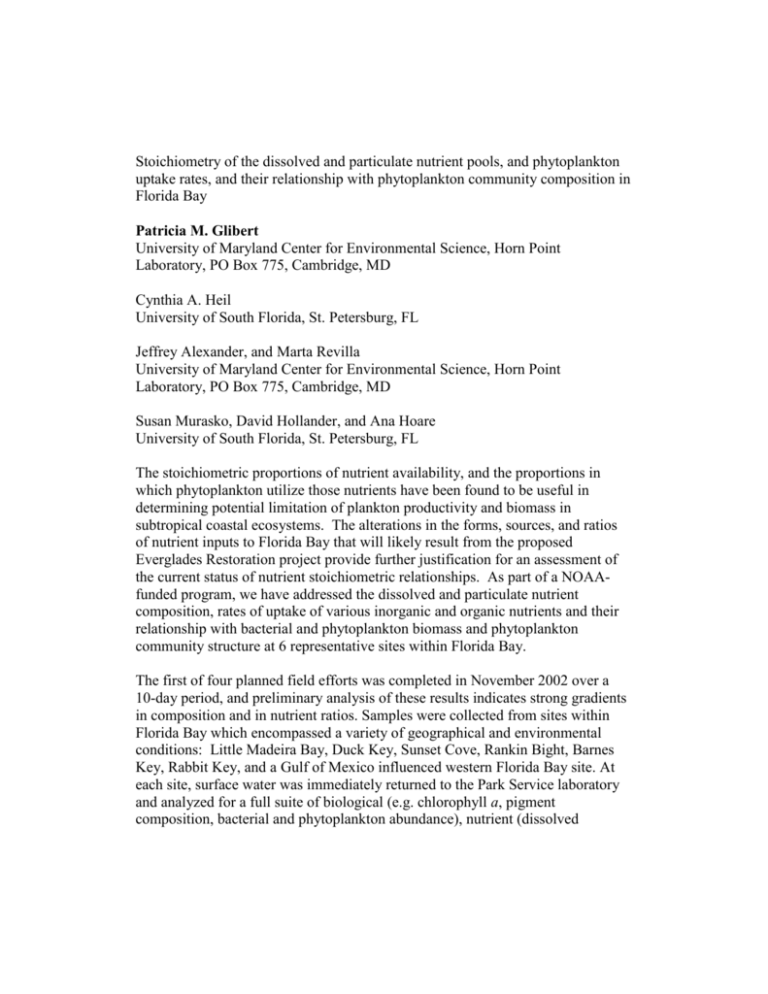
Stoichiometry of the dissolved and particulate nutrient pools, and phytoplankton uptake rates, and their relationship with phytoplankton community composition in Florida Bay Patricia M. Glibert University of Maryland Center for Environmental Science, Horn Point Laboratory, PO Box 775, Cambridge, MD Cynthia A. Heil University of South Florida, St. Petersburg, FL Jeffrey Alexander, and Marta Revilla University of Maryland Center for Environmental Science, Horn Point Laboratory, PO Box 775, Cambridge, MD Susan Murasko, David Hollander, and Ana Hoare University of South Florida, St. Petersburg, FL The stoichiometric proportions of nutrient availability, and the proportions in which phytoplankton utilize those nutrients have been found to be useful in determining potential limitation of plankton productivity and biomass in subtropical coastal ecosystems. The alterations in the forms, sources, and ratios of nutrient inputs to Florida Bay that will likely result from the proposed Everglades Restoration project provide further justification for an assessment of the current status of nutrient stoichiometric relationships. As part of a NOAAfunded program, we have addressed the dissolved and particulate nutrient composition, rates of uptake of various inorganic and organic nutrients and their relationship with bacterial and phytoplankton biomass and phytoplankton community structure at 6 representative sites within Florida Bay. The first of four planned field efforts was completed in November 2002 over a 10-day period, and preliminary analysis of these results indicates strong gradients in composition and in nutrient ratios. Samples were collected from sites within Florida Bay which encompassed a variety of geographical and environmental conditions: Little Madeira Bay, Duck Key, Sunset Cove, Rankin Bight, Barnes Key, Rabbit Key, and a Gulf of Mexico influenced western Florida Bay site. At each site, surface water was immediately returned to the Park Service laboratory and analyzed for a full suite of biological (e.g. chlorophyll a, pigment composition, bacterial and phytoplankton abundance), nutrient (dissolved inorganic and organic and particulate nutrients), isotopic (δ15N and δ13C particulate values) and rate (enzymatic and C, N, P and Si uptake) measurements. During this sampling period, phytoplankton blooms were encountered at Barnes and Rabbit Keys, with chlorophyll a values ranging from ~2 - >8 g l-1. Zeaxanthin: chlorophyll a ratios suggest that these were blue-green algae. Windinduced resuspension may have also contributed to elevated chlorophyll a at Barnes Key, as evidenced by the stable isotopic composition of the particulates. At all other stations, ambient chlorophyll a was <1g l-1, with fucoxanthin dominating as the accessory pigment. At all stations sampled, ambient inorganic nitrogen availability was <3 g at N l-1, with highest concentrations observed in the ammonium pool at Sunset Cove, Duck Key and Taylor Slough. A terrestrial source for this nutrient was apparent in the 15N of the particulate matter from these stations, with 15N values >10. Levels of inorganic nitrogen were <0.4 at Barnes and Rabbit Keys and at the Gulf station, and values of 15N of the particulate matter from those stations were significantly lower than the terrestrially influenced stations. Ratios of the ambient dissolved N:P nutrients were also substantially below Redfield ratios at Barnes and at the Gulf, and near Redfield proportions at Rabbit Key, adding further evidence of nitrogen limitation at these stations. Ratios of dissolved N:P were well in excess of Redfield proportions at the other sites, suggesting phosphorus limitation. No evidence of silica limitation was found at any site. Direct measurements of uptake rates of nitrogen and phosphorus are consistent with these relationships. Highest uptake rates of nitrogen (based on short term assays of isotopically-labeled nitrogen compounds at varying concentrations) were found at Rabbit and Barnes Keys and at the Gulf station, whereas lowest nitrogen uptake rates were noted at Sunset Cove. All stations exhibited higher uptake rates of ammonium than of the other nitrogenous substrates tested, but all stations also demonstrated substantial uptake of organic nitrogen. Highest phosphorus uptake rates (based on short term substrate depletion of additions of varying concentration) were determined at Sunset Cove, Rankin Bight and Duck Key, and lowest at Rabbit Key and at the Gulf Station. Further data analysis will permit an assessment of the elemental ratios of the particulate material from each station, and an assessment of the relationship between these ratios and those of their rates of uptake. Based on this preliminary view, phosphorus appears to be the predominant limiting nutrient at Sunset Cove and Duck Key, but nitrogen limitation appears to be the predominant limiting nutrient at Barnes Key and the Gulf station. Evidence of potential co-limitation by nitrogen and phosphorus is apparent at Rankin Bight, Little Madeira, and at Rabbit Key. The pattern of a transition from phosphorus to nitrogen limitation found within Florida Bay differs from Moreton Bay, Australia, another subtropical system where comparative analyses have been done. Moreton Bay is a shallow, estuarine embayment heavily impacted by urban nutrients and aquaculture where significant seagrass die-offs have occurred. For that system, both biomass and productivity are characterized by limitation by nitrogen but not by phosphorus. That system also differs from Florida Bay in the dominant blooms that develop upon nutrient loading. Patricia M. Glibert, University of Maryland Center for Environmental Science, Horn Point Laboratory, PO Box 775, Cambridge, MD, 21613 Phone: 410-221-8422, Fax: 410-221-8490, glibert@hpl.umces.edu , Question 3
